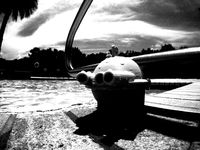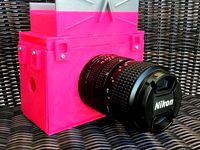Thingiverse

Autogiro by themindseye
by Thingiverse
Last crawled date: 3 years ago
Autogiro
or, Autogyro
An outlandish aircraft that files without a wing--distinguished from a helicopter whose rotary wing is driven by an engine--the autogiro features a self-rotating or auto-gyrating wing. Unlike this free-wheeling wing, however, the forward propulsion of an autogiro is generated by a conventional gasoline aircraft engine with propeller.
In 1923, Juan de la Cierva invented an aircraft that could fly at low speed which he named and later trademarked as an autogiro. This low speed attribute contributed to a short take-off roll, too. Both of these features made the autogiro an attractive commercial aircraft and Cierva founded the Cierva Autogiro Company. He sold the license production rights to different companies around the world including the A. V. Roe & Co. Ltd. in Britain.
The first British prototype flew in 1933 and was subsequently designated Avro Cierva C.30 Rota Mk 1A. These Rotas were employed by the Royal Air Force (RAF) for calibrating its fledging radar network prior to the start of the Battle of Britain.
Not all autogiros are Cierva derivatives, however. Unfortunately, the father of the autogiro, Cierva, was killed in an aviation accident at the Croydon airfield in 1936. This tragedy lead to other manufacturers carrying the autogiro torch. One such innovator in this legacy was Ken Wallis. Not wishing to infringe on the autogiro trademark, Wallis called his auto-gyrating wing contraption an autogyro. Furthermore, the Wallis autogyro was a pusher propelled aircraft that looked more like a souped-up riding lawn mower rather than a high-performance aircraft.
Sharp-eyed movie buffs will quickly point out that a Ken Wallis autogyro was featured in a major motion picture. The James Bond movie, You Only Live Twice "starred" a heavily-armed Wallis autogyro that was affectionately named Little Nellie by 007. Ostensibly created by gadget-genius "Q," Little Nellie's incredible (and real) flying stunts potentially hijacked the movie from Sean Connery--if you're an aviation enthusiast, that is.
The Model
The seven (you will need to print two rotors) major components for this model can all be individually printed on any 6- x 6-inch build platform 3D printer. The innovative rotor hub is based on the 1974 design of Dick Mathis. This hub, along with its two attached rotors, is loosely mounted on the fuselage pylon with an M4 screw. Just thread this screw tight enough to balance the rotor assembly on the pylon so that it can rotate freely. Additionally, the main undercarriage is designed to be clipped onto the bottom of the fuselage--not glued.
Additional Parts
If you'd like to give your model some animation, you will need a couple of extra parts. All of these parts can be ordered from Easy Built Models (http://www.easybuiltmodels.com) in Prattville, Alabama:
7-inch Peck Propeller (#R7P) $1.69
Large 2 1/2" Prop Shaft (6-pack) $2.99
Small 1 5/8" Prop Shaft (6-pack) $1.95 [Note: This shaft is used for attaching the rubber motor to the mount at the rear of the model.]
Small ERM Thrust Bearings (6-pack) $2.25
1/8" x 32 feet EBM Grey Rubber (#RE18) $2.75
And available from your local hardware store, for attaching the rotor plate to the autogiro's body:
(1) M4 x 15mm Machine Screw
References
So which spelling is correct? According to Oxford Dictionary, based on its Spanish etymology, "autogiro" is the preferred spelling.
"OTTO the Giro," by Dick Mathis; Model Airplane News, January 1974, pg. 17-19.
or, Autogyro
An outlandish aircraft that files without a wing--distinguished from a helicopter whose rotary wing is driven by an engine--the autogiro features a self-rotating or auto-gyrating wing. Unlike this free-wheeling wing, however, the forward propulsion of an autogiro is generated by a conventional gasoline aircraft engine with propeller.
In 1923, Juan de la Cierva invented an aircraft that could fly at low speed which he named and later trademarked as an autogiro. This low speed attribute contributed to a short take-off roll, too. Both of these features made the autogiro an attractive commercial aircraft and Cierva founded the Cierva Autogiro Company. He sold the license production rights to different companies around the world including the A. V. Roe & Co. Ltd. in Britain.
The first British prototype flew in 1933 and was subsequently designated Avro Cierva C.30 Rota Mk 1A. These Rotas were employed by the Royal Air Force (RAF) for calibrating its fledging radar network prior to the start of the Battle of Britain.
Not all autogiros are Cierva derivatives, however. Unfortunately, the father of the autogiro, Cierva, was killed in an aviation accident at the Croydon airfield in 1936. This tragedy lead to other manufacturers carrying the autogiro torch. One such innovator in this legacy was Ken Wallis. Not wishing to infringe on the autogiro trademark, Wallis called his auto-gyrating wing contraption an autogyro. Furthermore, the Wallis autogyro was a pusher propelled aircraft that looked more like a souped-up riding lawn mower rather than a high-performance aircraft.
Sharp-eyed movie buffs will quickly point out that a Ken Wallis autogyro was featured in a major motion picture. The James Bond movie, You Only Live Twice "starred" a heavily-armed Wallis autogyro that was affectionately named Little Nellie by 007. Ostensibly created by gadget-genius "Q," Little Nellie's incredible (and real) flying stunts potentially hijacked the movie from Sean Connery--if you're an aviation enthusiast, that is.
The Model
The seven (you will need to print two rotors) major components for this model can all be individually printed on any 6- x 6-inch build platform 3D printer. The innovative rotor hub is based on the 1974 design of Dick Mathis. This hub, along with its two attached rotors, is loosely mounted on the fuselage pylon with an M4 screw. Just thread this screw tight enough to balance the rotor assembly on the pylon so that it can rotate freely. Additionally, the main undercarriage is designed to be clipped onto the bottom of the fuselage--not glued.
Additional Parts
If you'd like to give your model some animation, you will need a couple of extra parts. All of these parts can be ordered from Easy Built Models (http://www.easybuiltmodels.com) in Prattville, Alabama:
7-inch Peck Propeller (#R7P) $1.69
Large 2 1/2" Prop Shaft (6-pack) $2.99
Small 1 5/8" Prop Shaft (6-pack) $1.95 [Note: This shaft is used for attaching the rubber motor to the mount at the rear of the model.]
Small ERM Thrust Bearings (6-pack) $2.25
1/8" x 32 feet EBM Grey Rubber (#RE18) $2.75
And available from your local hardware store, for attaching the rotor plate to the autogiro's body:
(1) M4 x 15mm Machine Screw
References
So which spelling is correct? According to Oxford Dictionary, based on its Spanish etymology, "autogiro" is the preferred spelling.
"OTTO the Giro," by Dick Mathis; Model Airplane News, January 1974, pg. 17-19.
Similar models
3dwarehouse
free

AUTOGIRO DLC
...23) 3d #3d #aeroplane #air #aircraft #aire #autogiro #aviación #avion #cierva #helicopter #jihs #nave #pilot #piloto #plane #ship
3dwarehouse
free

La Cierva derivative modern autogyro
...ller in your own models, but i do not recommend using the rest since i will finish this model when i have time. #cierva #gyro #la
3dwarehouse
free

Voyagyr Gyrocopter
...gyr gyrocopter
3dwarehouse
concept model for voyagyr ultralight gyrocopter #aircraft #autogiro #autogyro #gyrocopter #ultralight
thingiverse
free

Giroprint Mod by escu_12
... the commercial ones
removed a motor and added a servo for the tail
modified rotor to use "luobo v2s" autogyro bearings
grabcad
free

Quadcopter
...or-craft, as opposed to fixed-wing aircraft, because their lift is generated by a set of rotors (vertically oriented propellers).
3d_ocean
$35

Aviocopter concept aircraft
...der internal render. model consists of: front wings, rear tale, fuselage, cockpit and propellers with engines. parts are separ...
cg_trader
$24

Red Stripe Propeller Blade
... part impeller transport spinner fan civil sport melal rotor aircraft aircraft part aircraft engine airplane engine airplane wing
3dwarehouse
free

Vehicles from 'Things to Come' 1936
...s. #aircraft #art_deco #autogyro #hg_wells #movie #plane #revised #sci_fi #scifi #tank #things_to_come #wings_over_the_world #wow
3dwarehouse
free

Vehicles from 'Things to Come' 1936
...s. #aircraft #art_deco #autogyro #hg_wells #movie #plane #revised #sci_fi #scifi #tank #things_to_come #wings_over_the_world #wow
grabcad
free

helicopter completed model
...h them from fixed-wing
aircraft, because the helicopter derives its source of lift from the rotor blades rotating around a mast.
Autogiro
thingiverse
free

Turnigy Auto-G2 main hub replacement part by Painless360
...part for the central hub in the turnigy auto-g2 autogiro model. this is 0.5mm thicker to take into account...
thingiverse
free

Giroprint Mod by escu_12
...hechas al giroprint para hacerlo mas "real" a los autogiro como los comerciales quitado un motor y añadido un...
thingiverse
free

Helicopter - Gyro Kite by CuervoRC
...cometa que se basa en el diseño de un autogiro http://thehelicopterkite.tripod.com/ ¡atención! todavía está en fase de pruebas, no...
grabcad
free

Autogiro Ligiro
...autogiro ligiro
grabcad
my autogiro
grabcad
free

Oriata AutoGiro
...oriata autogiro
grabcad
a rendering of my "oriata" rescue autogiro modeling with autodesk alias
grabcad
free

TRACTOR AUTOGIRO
...
i build a tractor autogiro with a fuselage of flight design ct2k
first takeoff https://www.youtube.com/watch?v=h5ot59jz6nc
cg_trader
$20

Autogiro LaCierva
...onal, can´t crash, and is cheap to build and to run it.
of course, it´s the grandfather of all helicopters and quadricopters.
grabcad
free

AUTOGIRE RB01
...autogire rb01 grabcad i build this autogiro for my hobby, i am the...
grabcad
free

COPTER´s story
...story grabcad as a tribute to la cierva autogiro http://es.wikipedia.org/wiki/autogiro , antonio pinfor™ will begin to publish a history...
Themindseye
thingiverse
free

The Voyage of the Bathysphere by themindseye
...the voyage of the bathysphere by themindseye
thingiverse
a 3d replica of the 1934 bathysphere with presentation plaque.
thingiverse
free

Ped101 by themindseye
... time, and temperature displays).
the complete project code and assembly details can be found at:
http://how2-oh.github.io/ped101
thingiverse
free

ThinkFun Plate Expansion Kit by themindseye
...nd 4x4 (large) for thinkfun maker studio. this thing is one part of a three part expansion kit series: brackets, plates, threads.
thingiverse
free

ThinkFun Bracket Expansion Kit by themindseye
...egree 2x3, 130-degree 2x2, and 130+-degree 2x3. this is one part of a three part expansion kit series: brackets, plates, threads.
thingiverse
free

Weather Box by themindseye
...her box is about 100+ days.
you can find the electronics building instructions and arduino code at:
how2-oh.github.io/weather-box
thingiverse
free

piOneer by themindseye
...t was featured in issue #50 of the magpi magazine:https://raspberrypi.org/magpi-issues/magpi50.pdf
[this is a free pdf download.]
thingiverse
free

ThinkFun Threads Expansion Kit by themindseye
...and printer variance might require increasing (e.g., nuts) 1-3% and decreasing (e.g., threaded parts) 1-3% sizes for optimal fit.
thingiverse
free

AIRflex by themindseye
...y pink? as acknowledgment of breast cancer awareness month, the airflex was printed in magenta pla with a silver pla accent band.
thingiverse
free

The Thankful Turkey by themindseye
..."feathered" thanks
note: the thankful turkey is an adaptation of a commercial product, "turkey on the table."
thingiverse
free

Greeting Knob by themindseye
...torials/accelerated-aging-your-metal-bearing-3d-prints
note: greeting knob is pull handle and not an operating cylinder doorknob.
